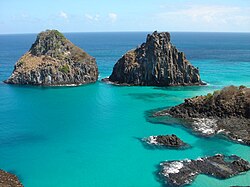This article needs additional citations for verification .(October 2023) |



A tidal island is a raised area of land within a waterbody, which is connected to the larger mainland by a natural isthmus or man-made causeway that is exposed at low tide and submerged at high tide, causing the land to switch between being a promontory/peninsula and an island depending on tidal conditions.
Contents
Because of the mystique surrounding tidal islands, many of them have been sites of religious worship, such as Mont-Saint-Michel with its Benedictine abbey. Tidal islands are also commonly the sites of fortresses because of the natural barrier created by the tidal channel.







